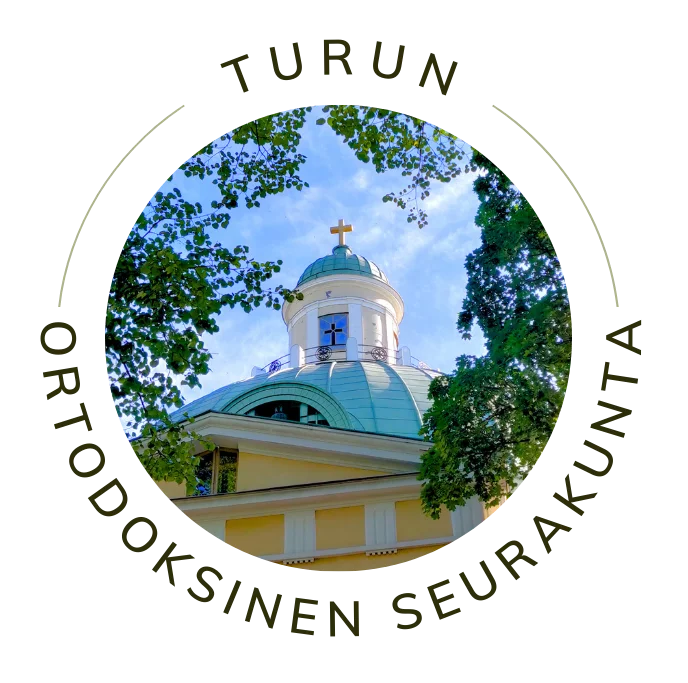The replica of the ”Intercession of the Theotokos” (Pokrova) icon, created on an armored plate in February–March 2025, is a unique masterpiece of Ukrainian sacred art, distinguished by its intricate and multi-figure composition. The icon was commissioned by the Ukrainians of Finland association (Suomen Ukrainalaiset ry) and presented as a gift to the Church of the Holy Martyr Empress Alexandra in the city of Turku, which belongs to the Orthodox Church of Finland—an autonomous Orthodox Church under the Ecumenical Patriarchate of Constantinople.
Designed specifically for the spiritual needs of the Ukrainian community, the icon will serve as a place of prayer during baptisms, weddings, intercessions for the health of loved ones, and commemorations of the deceased and fallen. It is not only a sacred artistic relic but also a symbol of the resilience, faith, and triumph of the Ukrainian people.
In the upper part, against a golden background, the Mother of God stands on clouds, holding the protective veil. On either side, two angels hover, touching her crown. Below them stand Saint John the Baptist (on the left) and Saint John the Theologian (on the right), bowing in prayer.
The central figure in the lower part is Romanos the Melodist, depicted on a two-tiered ambo in front of the carved royal doors of the iconostasis. His right hand is raised in a gesture of blessing, while his left hand holds a scroll.
To his left are historical figures: Pereiaslav Colonel Semen Sulyma, Emperor Leo VI the Wise holding a scepter and orb, acting Hetman Ivan Sulyma, and Empress Theophano Martinakia. To his right are Paraskeva Sulyma, Kyiv Metropolitan Rafail Zaborovskyi, Saint Andrew the Fool, and his disciple Epiphanius, dressed in a black mantle and klobuk, holding a prayer rope.
The architectural background includes two Corinthian pilasters and an iconostasis with embedded images of the Theotokos (on the left) and Christ (on the right), creating a sense of space and adding symbolic completeness to the composition.
The icon was painted by masters from Ukraine, a creative collective of iconographers known as B&T.Us (Brave and Talented Ukrainians). Its dimensions are 30 cm × 25 cm × 2,5 cm.
A traditional Ukrainian rushnyk, decorated with plant motifs characteristic of Ukrainian culture, is also added along with the icon. It serves as a protective amulet and complements the icon, highlighting its festive and protective nature. The rushnyk was made by the craftswoman Nataliya Kos (selo of Serednii Maidan, Ivano-Frankivsk Oblast, Ukraine).
”Intercession of the Theotokos” Icon: History, Composition, and Social Significance
The icon ”Intercession of the Theotokos” (Pokrova) was created for the Pokrova Church in the village of Sulymivka and is a striking example of Ukrainian Baroque. It was painted between 1739 and 1741 and holds significant cultural, historical, and genealogical value. In addition to its religious function, the icon also serves to glorify the good deeds of the Sulyma family, as it is a ktitor portrait (a donor portrait). This type of icon was popular during the Hetmanate period when hetmans and Cossack leaders commissioned them not only as sacred images but also as symbols of their piety and high social status.
The icon is painted on a wooden board covered with levkas, using oil paints, gilding, and silvering. Its dimensions are 110 cm × 78 cm. The original icon is preserved in the Sulyma Gallery of the National Art Museum of Ukraine in Kyiv.
At the center of the composition, the Mother of God is depicted in the traditional ”Pokrova” pose, emphasizing her role as a protector. She hovers above the altar screen, surrounded by angels and saints. Below, beside the royal doors, are groups of people from various social backgrounds, including saints Andrew the Fool, Epiphanius, Romanos the Melodist, as well as Emperor Leo VI the Wise and Empress Theophano Martinakia – figures typical of Byzantine iconography. The presence of these saints alongside historical figures underscores the connection between the heavenly and earthly realms.
Particular attention is drawn to the portraits of Ivan Sulyma, the commander of the Zaporizhian Cossacks, and his descendants. Ivan Sulyma is depicted wearing a red ceremonial military coat with golden buttons, over which he wears a dark blue cloak trimmed with ermine fur, fastened with a fibula, highlighting his noble lineage. He belonged to an old warrior family that bore the ”Sulyma” coat of arms. To the right of the center is his great-grandson, Semen Sulyma, the Pereiaslav colonel, dressed in a green coat. He is the patron who commissioned this icon. To the left is his wife, Paraskeva Sulyma, daughter of Lubny Colonel Vasyl Savych.
The icon has both sacred and secular significance, as it features realistic portraits of prominent historical figures. Among them are a beggar, an emperor and empress, a proud hetman, and a sorrowful Cossack, adding depth and meaning to the work. These figures not only symbolize sacred themes but also illustrate the contrasts between different social classes of the time, highlighting the complexity and diversity of Ukrainian society in the 17th–18th centuries.
Beneath the high church vaults, against the backdrop of a luxurious baroque gilded iconostasis, a solemnly dressed congregation is depicted. In the foreground stand the emperor, noblewomen, Cossacks, their wives, and clergy. The artist, following the patron’s wishes, emphasizes secular figures, creating an image that is not only religious but also almost ceremonial. The icon is not just a sacred representation but also part of courtly culture, where the public affirmation of the Sulyma family’s high status is as important as the spiritual message.
The ”Intercession of the Theotokos” (Pokrova) icon is not only a religious artifact but also an important historical and cultural document. It is a remarkable example of Ukrainian Baroque, combining elements of sacred art with realistic portrayals of historical figures and social groups.

